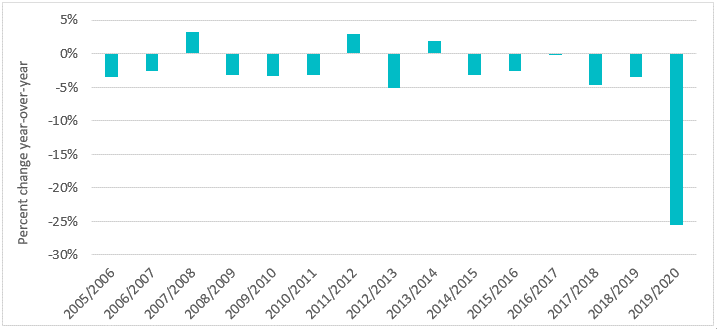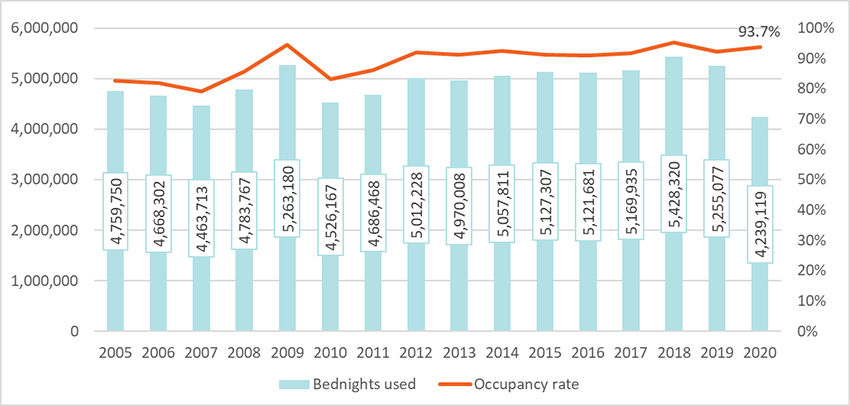Homelessness Data Snapshot: The National Shelter Study 2020 Update
On this page
- Introduction
- Data
- Research findings
- Demographics
- Chronic homelessness among shelter users
- Limitations
- Key findings
- For more information
Introduction
The National Shelter Study is an ongoing analysis of trends in homelessness shelter use in Canada. The present report provides an update on trends in 2020, the first year of the COVID-19 pandemic. This year saw substantial shifts in the service landscape. Overall capacity in the permanent emergency shelter system was reduced significantly partway through the year to adhere to public health measures. The methodology has been adjusted to account for monthly changes in the bed capacity of permanent emergency shelters.
Data
This analysis covers the period from 2005 to 2020 and uses data collected from:
- the Homeless Individuals and Families Information System (HIFIS), and
- provincial and municipal partners that have data sharing agreements with the Government of Canada.
Approximately 50% of emergency shelters in Canada were included in this analysis, representing about 70% of available emergency shelter beds. The methodology takes into account people who use more than one shelter. Domestic violence shelters, immigrant and refugee shelters, and transitional housing are not included due to insufficient data coverage. The federal government continues to explore ways to incorporate the use of other types of shelters including winter and temporary COVID isolation centres in the analysis for 2020 and beyond.
Research findings
Impact of the COVID-19 pandemic on the shelter system
There was a 29.9% drop in total permanent emergency shelter capacity (nearly 4,800 beds) over the course of 2020 after the onset of the COVID-19 pandemic. This impact was widespread, affecting youth shelters (average decrease of 34.2%), general shelters (average decrease of 31.4%) and family shelters (average decrease of 18.2%). This substantial decrease of shelter capacity likely contributed to a reduction in the number of people accessing the shelter system in 2020 compared to previous years.
Interpreting changes in shelter use in 2020
When looking at trends in shelter use over time, it is important to consider results from 2020 in the appropriate context. The COVID-19 pandemic progressed quickly and was coupled with a variety of government and individual responses including the Canada Emergency Response Benefit (CERB), eviction moratoria, shelter-in-place lockdowns, social distancing rules, shelter capacity reductions, etc. The combination of these elements contributed to temporary reductions in shelter use, however, this should not be equated with a reduction in homelessness.
This analysis does not capture homelessness in contexts outside of the permanent shelter system including temporary sites, couch surfing and rough sleeping. While this is true of all years of National Shelter Study analysis, it is an especially important point to remember in 2020 because it excludes those who could not access shelter due to capacity reductions or those who chose not to access the permanent shelter system in order to avoid exposure to the virus. Findings from Point-in-Time counts of homelessness conducted during the pandemic suggest that unsheltered homelessness increased in many communities compared to pre-pandemic counts.
Extent of shelter use
In 2020, an estimated 88,342 people experienced homelessness in a permanent emergency shelter, compared to 118,759 in 2019. On an average night, there were approximately 11,600 people staying in shelters, compared to 14,400 in 2019.
Leading up to the pandemic, between 2005 and 2019, the overall number of shelter users was trending downwards. The drop was more pronounced in 2020. Between 2019 and 2020, shelter users decreased by 25.6%.
Figure 1: Number of shelter users from 2005 to 2020

-
Figure 1 - Text version
Year Number of permanent emergency shelter users 2005 156,030 2006 150,663 2007 146,884 2008 151,621 2009 146,726 2010 141,854 2011 137,415 2012 141,405 2013 134,262
Figure 2 shows that the number of people using permanent emergency shelters generally declined slowly between 2005 and 2019 (23.9% cumulatively over fourteen years) with a sharp drop in 2020 (25.6% in one year).
Figure 2: Percent change in number of shelters users year over year from 2005 to 2020

-
Figure 2 - Text version
Year interval Year-over-year change in number of shelter users 2005/2006 -3.4% 2006/2007 -2.5% 2007/2008 3.2% 2008/2009 -3.2% 2009/2010 -3.3% 2010/2011 -3.1% 2011/2012 2.9% 2012/2013 -5.1% 2013/2014 1.9% 2014/2015 -3.2% 2015/2016 -2.6% 2016/2017 -0.1% 2017/2018 -4.7% 2018/2019 -3.4% 2019/2020 -25.6%
Although the total number of shelter users decreased, demand for shelter beds remained high. The average occupancy rate among all shelters in 2020 was 93.7%. The occupancy rate for youth shelters was 73.1%, while general shelters had an occupancy rate of 97.9%, and family shelters had an occupancy rate of 83.6%. This high occupancy was driven by longer stays in shelter. In 2005, the average shelter stay among all shelter users was 30.5 days. In 2020, the average stay had climbed to 48.0 days.
Figure 3: Bednights used vs. shelter occupancy rates from 2005 to 2020

-
Figure 3 - Text version
Year bednights used Occupancy rate 2005 4,759,750 82.7% 2006 4,668,302 82.0% 2007 4,463,713 79.1% 2008 4,783,767 85.7% 2009 5,263,180 94.6% 2010 4,526,167 83.2% 2011 4,686,468 86.3% 2012 5,012,228 91.9% 2013 4,970,008 91.2% 2014 5,057,811 92.4% 2015 5,127,307 91.2% 2016 5,121,681 91.0% 2017 5,169,935 91.7% 2018 5,428,320 95.2% 2019 5,255,077 92.3% 2020 4,239,119 93.7%
Demographics
Age
In 2020, accompanied children (aged 0-16) represented 3.7% of shelter users. Youth (aged 13-24) made up 13.3% of shelter users. The majority (58.6%) of shelter users were adults (aged 25-49). Older adults (aged 50-64) were 20.7% of the shelter user population and seniors (aged 65+) were 3.6%. Between 2005 and 2020, there was a statistically significant decrease in the proportion of youth among shelter users (19.0% to 13.3%). The average age of shelter users in 2020 was 38.9 years.
Gender
In 2020, 69.0% of shelter users were men, 30.0% were women, and 1% identified as gender diverse. The proportion of men and women remained statistically unchanged between 2005 and 2020. However, the proportion of shelter users reporting as gender diverse increased in a statistically significant way between 2015 (0.5%) and 2020 (1.0%).
Indigenous Peoples
The proportion of Indigenous shelter users remained consistent between 2015 and 2020, and Indigenous people continued to be overrepresented in Canada's emergency shelters. According to the 2021 census, Indigenous peoples represent about 5.0% of the Canadian population, yet the percentage of shelter users in 2020 who identified as Indigenous was 35.0%, as shown in figure 4.
Figure 4: Proportion of shelter-using population and general population by Indigenous status

-
Figure 4 - Text version
Population Non-Indigenous (percentage) Indigenous (percentage) Shelter users 65.0% 35.0% General population 95.0% 5.0%
Veterans
An estimated 1.5% of shelter users in 2020 reported serving as either Canadian Armed Forces, former RCMP officers, veterans of allied countries, or civilian veterans. This is consistent with the estimated overall proportion of veterans in CanadaFootnote 1 (1.7%). There was a steady downward trend in the number of veterans accessing homeless shelters between 2017 and 2020, though the difference in proportion from previous years is not statistically significant.
Citizenship
In 2020, the majority (89.6%) of shelter users were Canadian citizens. The proportion of refugees and refugee claimants in the shelter system decreased from 4.1% in 2019 to 1.5% in 2020, which may have resulted from a decrease in the number of irregular border crossings in 2020 due to pandemic travel restrictionsFootnote 2.
Chronic homelessness among shelter users
In 2020, data from a subset of 18 communities were used to estimate chronic homelessness in Canada. The sample included 36,354 shelter users (accounting for 41.2% of total estimated shelter users in 2020). Shelter users are considered chronically homeless if they meet at least one of the following criteria:
- 1-year chronic-homelessness: used a shelter for six months (180 days) or more in the past year
- 3-year chronic homelessness: had shelter stays in each of the last three years
In 2020, a total of 31.7% of shelter users in the sample met one or both of the criteria for chronic homelessness (up from 25.2% in 2019). By applying this proportion to the national estimate of shelter users, an estimated 28,004 shelter users experienced chronic homelessness in 2020, similar to the estimate from 2019 (29,927).
In 2020, 15.9% of shelter users met the criteria for 1-year chronic homelessness only, 9.9% for 3-year chronic homelessness only, and 5.5% for both 1- and 3-year chronic homelessness.
From 2017 to 2020, there was an significant increase in the proportion of shelter users who met only the 1-year chronic homelessness indicator (from 9.0% to 15.9%). Over that same period, the proportion who experienced 3-year chronic homelessness remained stable (from 9.9% to 9.9%). While the proportion who experienced both 1- and 3-year chronic homelessness was relatively stable between 2017 and 2019 (from 3.5% to 3.8%), but increased from 2019 to 2020 to 5.5% of all shelter users.
Limitations
Over the course of the COVID-19 pandemic, the homeless service landscape changed significantly. As frontline services scrambled to meet public health guidelines, there was a shift from reliance on the traditional emergency shelter system to temporary service locations including hotels/motels, and makeshift use of public spaces. This tested the adaptability and resilience of Homelessness Management Information Systems in place and made it difficult to accurately capture the capacity of the shelter system and the size of the shelter population at the national level. The federal government continues to explore ways to incorporate the use of other types of shelters including winter and temporary COVID isolation centres in the analysis for 2020 and beyond.
The COVID-19 pandemic was coupled with a variety of government and individual responses including the Canada Emergency Response Benefit (CERB), eviction bans, rent increase freezes, shelter-in-place lockdowns, social distancing rules, shelter capacity reductions, etc. The combination of these elements contributed to temporary reductions in shelter inflow, however, this should not be conflated with a reduction in homelessness as this study does not capture homelessness in contexts outside of the shelter system, including couch surfing and rough sleeping.
While this is true of all years, it is an especially important point to remember in 2020 because it excludes those who could not access shelter due to capacity reductions or those who chose not to access shelters in order to avoid exposure to the virus. Therefore, the 2020 results likely more significantly underrepresent homelessness in Canada compared to previous years.
Key findings
- In 2020, the COVID-19 pandemic had a significant impact on homeless service delivery, significantly reducing access to shelter space. The number of individuals accessing shelters decreased substantially after April 2020 (-25.6%), but demand for shelter beds remained high.
- In 2020, the majority of shelter users were adults aged 24 to 49 (58.6%) and men (69.0%). The average age of shelter users was 38.9 years.
- Indigenous peoples were overrepresented among shelter users in 2020, with 35.0% of shelter users identifying as Indigenous, compared to 5.0% of the general Canadian population.
- In 2020, 1.5% of shelter users reported to have served as either Canadian Armed Forces, former RCMP officers, veterans of allied countries, or civilian veterans.
- The majority of shelter users identified as Canadian citizens (89.6%). The proportion of shelter users who identified as refugees and refugee claimants decreased in 2020, which may be explained by border closures due to pandemic restrictions.
- An estimated 27,651 shelter users experienced chronic homelessness in 2020, relatively unchanged from 2019 (29,927).
For more information
To find out more about homelessness research, visit the Data analysis, reports and publications page.
If you have any questions about this report, contact us.
Report a problem on this page
- Date modified: